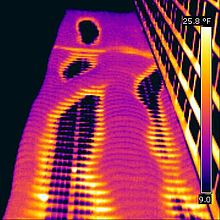

A thermal bridge, also called a cold bridge, heat bridge, or thermal bypass, is an area or component of an object which has higher thermal conductivity than the surrounding materials,[1] creating a path of least resistance for heat transfer.[2] Thermal bridges result in an overall reduction in thermal resistance of the object. The term is frequently discussed in the context of a building's thermal envelope where thermal bridges result in heat transfer into or out of conditioned space.
Thermal bridges in buildings may impact the amount of energy required to heat and cool a space, cause condensation (moisture) within the building envelope,[3] and result in thermal discomfort. In colder climates (such as the United Kingdom), thermal heat bridges can result in additional heat losses and require additional energy to mitigate.
There are strategies to reduce or prevent thermal bridging, such as limiting the number of building members that span from unconditioned to conditioned space and applying continuous insulation materials to create thermal breaks.
- ^ Binggeli, C. (2010). Building Systems for Interior Designers. Hoboken, NJ: John Wiley & Sons.
- ^ Gorse, Christopher A., and David Johnston (2012). "Thermal bridge", in Oxford Dictionary of Construction, Surveying, and Civil Engineering. 3rd ed. Oxford: Oxford UP, 2012 pp. 440-441. Print.
- ^ Arena, Lois (July 2016). "Construction Guidelines for High R-Value Walls without Exterior Rigid Insulation" (PDF). NREL.gov. Golden, CO: National Renewable Energy Laboratory (NREL).